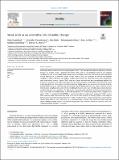Weak acids as an alternative anti-microbial therapy
Author(s)
Kundukad, Binu; Udayakumar, Gayathri; Grela, Erin; Kaur, Dhamanpreet; Rice, Scott A; Kjelleberg, Staffan; Doyle, Patrick S; ... Show more Show less
DownloadPublished version (2.256Mb)
Publisher with Creative Commons License
Publisher with Creative Commons License
Creative Commons Attribution
Terms of use
Metadata
Show full item recordAbstract
Weak acids such as acetic acid and N-acetyl cysteine (NAC) at pH less than their pKa can effectively eradicate biofilms due to their ability to penetrate the biofilm matrix and the cell membrane. However, the optimum conditions for their activity against drug resistant strains, and safety, need to be understood for their application to treat infections or to inactivate biofilms on hard surfaces. Here, we investigate the efficacy and optimum conditions at which weak acids can eradicate biofilms. We compared the efficacy of various mono and triprotic weak acids such as N-acetyl cysteine (NAC), acetic acid, formic acid and citric acid, in eradicating biofilms. We found that monoprotic weak acids/acid drugs can kill mucoid P. aeruginosa mucA biofilm bacteria provided the pH is less than their pKa, demonstrating that the extracellular biofilm matrix does not protect the bacteria from the activity of the weak acids. Triprotic acids, such as citric acid, kill biofilm bacteria at pH < pKa1. However, at a pH between pKa1 and pKa2, citric acid is effective in killing the bacteria at the core of biofilm microcolonies but does not kill the bacteria on the periphery. The efficacy of a monoprotic weak acid (NAC) and triprotic weak acid (citric acid) were tested on biofilms formed by Klebsiella pneumoniae KP1, Pseudomonas putida OUS82, Staphylococcus aureus 15981, P. aeruginosa DK1-NH57388A, a mucoid cystic fibrosis isolate and P. aeruginosa PA_D25, an antibiotic resistant strain. We showed that weak acids have a broad spectrum of activity against a wide range of bacteria, including antibiotic resistant bacteria. Further, we showed that a weak acid drug, NAC, can kill bacteria without being toxic to human cells, if its pH is maintained close to its pKa. Thus weak acids/weak acid drugs target antibiotic resistant bacteria and eradicate the persister cells in biofilms which are tolerant to other conventional methods of biofilm eradication.
Date issued
2020Department
Singapore-MIT Alliance in Research and Technology (SMART); Massachusetts Institute of Technology. Department of Chemistry; Massachusetts Institute of Technology. Department of Mathematics; Massachusetts Institute of Technology. Department of Chemical EngineeringJournal
Biofilm
Publisher
Elsevier BV